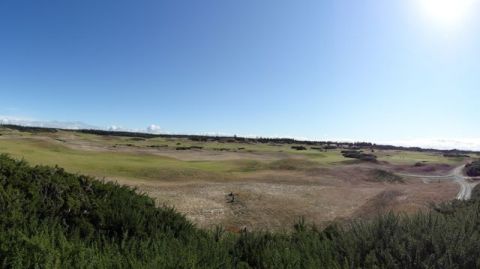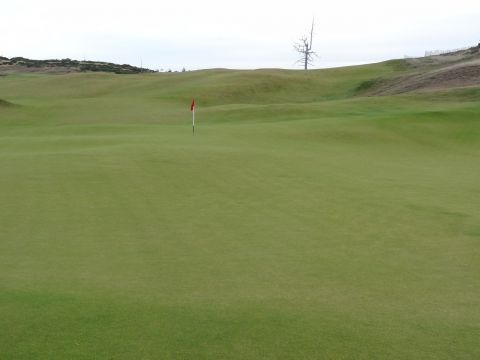Text and golf photos by Scott Simpson
There can be no really first class golf course without good material to work with. The best material is a sandy loam in gentle undulation, breaking into hillocks in a few places. Securing such land is really more than half the battle. Having such material at hand to work upon, the completion of an ideal course becomes a matter of experience, gardening and mathematics. -- C.B. Macdonald
Imagine for a moment that you’re Mike Keiser, circa 2005. You’re the toast of the golf world as a result of the improbable success of your Bandon Dunes Golf Resort on the remote southern coast of Oregon. You’ve been told repeatedly that you’ll never lure enough golfers to make the project profitable, that golf cart rental fees are necessary to make the economics work and that Americans will never put up with the cold and wet conditions of the Oregon coast. But with the opening of each of your three acclaimed golf courses, you’ve served up a healthy helping of crow to these critics.
You’ve assembled an attractive 300-acre parcel to the north of Pacific Dunes. This parcel has less extensive ocean frontage than the wildly successful Bandon and Pacific Dunes, but provides the same sandy substrate perfect for links golf. Every golf architect on the planet has made a pilgrimage to southern Oregon in hopes of burnishing their reputations on this spectacular canvas. Surely it was just a matter of picking from among these highly skilled architects and awaiting the inevitable fourth masterpiece.

Utilizing the way-cool sweep panorama feature of my new camera, a view of the Old Macdonald property from the adjoining 14th hole of Pacific Dunes. The property appears to be flat from a distance, but up close an endless series of hummocks and landforms are revealed, very reminiscent of the Old Course at St. Andrews.
But if Mike Keiser were prone to conventional thinking, the Bandon Dunes property would still be a gorse-infested blight. If you’re Mike Keiser, you trust your instincts and you go big, commissioning the most architecturally ambitious golf course project in decades, an homage to a golf course architect whose name most American golfers wouldn’t recognize and whose design concepts -- such as blind shots, penal bunkering and the importance of the ground game – are alien to the evolution of American golf. Fortunately for us all, Mike Keiser hit it out of the park, creating a golf course one can enjoy as an architectural history lesson, a stout test of golf or both. Then, with tongue planted firmly in cheek, he named it after the most annoying of children’s songs, ensuring that the endeavor not be considered some dry history lesson or museum piece.
Living in Chicago, Keiser undoubtedly became familiar with C.B. Macdonald’s work at Chicago Golf Club and Shoreacres. His extensive golf travels familiarized him with the original courses that Macdonald so revered and he also had ample opportunity to experience Macdonald’s enduring legacy, The National Golf Links of America. And, in a world where timing is everything, it is somehow appropriate that Old Macdonald opened for play almost exactly one hundred years after the opening of The National.
As Keiser focused on incorporating Macdonald’s work into his next project, his first instinct was perhaps even more audacious than the ultimate Old Macdonald concept. He consulted with George Bahto, whom we met during our visit to Sleepy Hollow (read the author's Sleepy Hollow article here), to assess the feasibility of creating a replica of Macdonald’s
Old Mac almost became a replica of the legendary Lido Golf Club, but most evidence of Lido's design had vaporized.
legendary Lido Golf Club. Bahto had authored the definitive Macdonald biography,
The Evangelist of Golf. The Lido, built entirely on landfill at the then-incomprehensible sum of $10 million, including its 400 room Spanish Mission clubhouse, has achieved mythic status in the golf world. Upon completion in 1915, it was hailed as no less of an accomplishment than The National, but it failed during the Great Depression and no meaningful records or photographs of the golf course have survived. The Lido, to paraphrase Sydney Greenstreet, is the stuff that dreams are made of.
In subsequent discussions with Tom Doak, Bahto and others, Keiser’s thinking moved beyond a reproduction of the Lido, as fascinating as that might have been. At Doak’s urging, he gravitated towards the concept of building a golf course as Macdonald might have, replicating not a specific design but the design process itself. Keiser was reportedly brutally honest in his intentions, telling Doak and co-designer Jim Urbina candidly that he already had a Tom Doak course and didn’t need a second. (Urbina had performed the same role, albeit without the design credit, on Pacific Dunes) He wanted and expected a Charles Blair Macdonald course; specifically he wanted his design team to identify and utilize the natural features of the land, as they envisioned Macdonald would do if presented with the site.

A partial view of the 5th green, Old Mac’s Short hole. This perspective gives a feel for the elevation change on this vast green of more than 20,000 square feet. The 10th green, seen in the background, shares a cavernous bunker with the 5th.
To assure the broadest base of knowledge of all things Macdonald, Keiser assembled a dream team advisory board. Bahto, Macdonald’s biographer and a golf course architect in his own right, was an obvious selection. Keiser additionally recruited Karl Olson, longtime greens superintendant at The National, and Brad Klein, architecture editor and in charge of course ratings for Golfweek Magazine. In one of my favorite vignettes from the development of the project, responsibility for specific holes was allocated to the advisory board through an NFL-style draft. Imagine the dilemmas involved if you were lucky enough to be on the advisory panel: Do you grab the Road Hole in the first round of the draft, or gamble that it will still be there when your turn comes up in Round Two?
Not only did this unwieldy-sounding committee not produce a camel, but the horse they created is a pure thoroughbred. The wonder is less that they successfully incorporated so many of the classic design templates
It may take some effort to lose a golf ball at Old Mac, but that doesn't make it easy.
from the Macdonald/Seth Raynor oeuvre, but that they were fearless enough to throw out the playbook when appropriate which is, after all, what C.B. himself would have done. For instance, while the four one-shotters utilize the templates any armchair critic could have predicted -- namely an Eden, Short, Redan and Biarritz -- the preferred routing left three of these on the outbound nine (though this routing seems downright conventional in comparison to neighboring Pacific Dunes, where the back nine includes no fewer than four Par 3’s and only two Par 4’s). It’s in the longer holes where we see the apostasy from the Macdonald canon to great effect, most notably on the 7th hole.
The course features extremely wide playing corridors, with some of the widest fairways you’ll ever see, inviting the inevitable comparison to the Old Course at St. Andrews. This makes the course eminently playable for golfers of all abilities, and it takes some effort or bad luck to actually lose a golf ball. But the width can be deceiving and is always part of the strategic test of the hole. Again incorporating the design ethic of the Old Course, the player is typically faced with a choice of lines off the tee. The inevitable choice is between the safer line, which will inevitably leave a longer or less desirable angle on the approach shot, versus a more aggressive line which will invariably bring the well-placed hazards, mostly penal fairway bunkers, into play.
Next: Lay of the Land




























